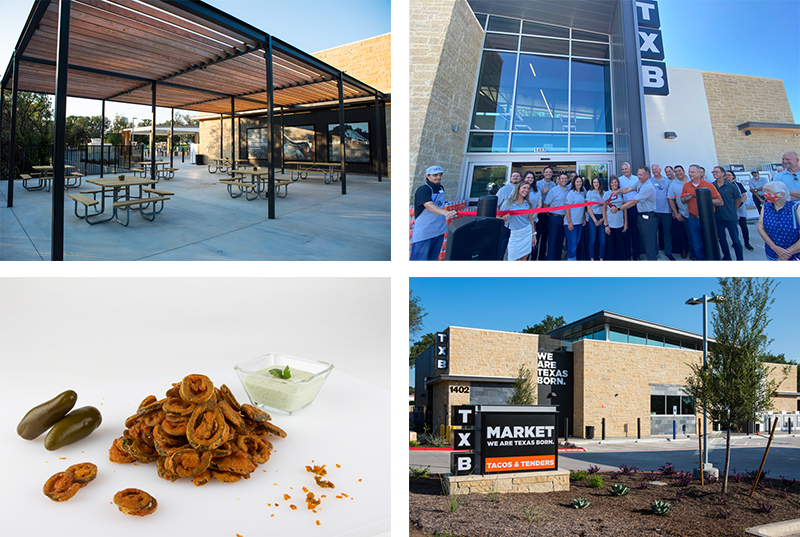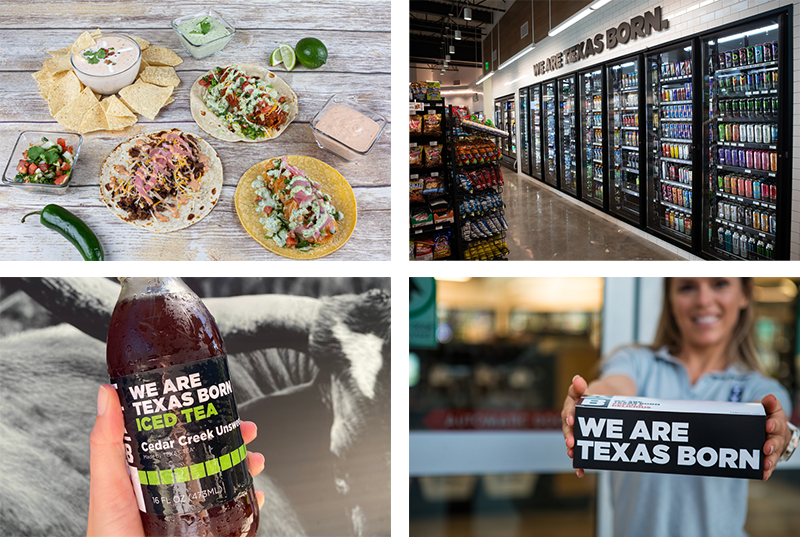Kevin Smartt’s vision for his growing retail business is that “it will be known, first, as a food destination and a high-quality place to shop, as well as a place for energy needs—whether it’s fuel or electric.” With a major chain rebrand underway—and an immediate strong response from consumers—Smartt, the CEO of Texas Born Inc. (TXB), is well on his way to realizing his goal.
Formerly known as the Kwik Chek chain of convenience stores, TXB is the reimagined concept comprised of 46 units in Texas and Oklahoma, stretching 1,250 miles north to south and 950 miles east to west. The company was founded in 1972 as a fuel distributor, McCraw Oil, and the first Kwik Chek launched in the late 1980s, according to Smartt. He joined the company in 1992, and “worked in various positions throughout the company, moving from the ground up,” he said. In 2001, Smartt and his now late partner Doyce Taylor bought the business and went on to double its size—both for fuel distribution and retail. Since Taylor’s death two years ago, Smartt has acquired 100% of the company. Headquartered in Spicewood, Texas, TXB employs about 600 workers, and its sister fuel distributorship operation boasts 150 workers.
While a rebranding had long been on the table, the official transitioning of Kwik Chek to TXB wasn’t announced until late last year. “It exemplifies who we are as a company,” explained Smartt, NACS 2020-21 chairman, of the move. “We are Texas Born. I’ve lived all throughout the state of Texas and have great pride in my roots.” Moreover, he added, the concept’s new branding “emphasizes our values of authenticity, integrity and hospitality.”
We elected to not put in any indoor seating, opting strictly for outdoor dining.
Prototype Unveiled
While the company is in the process of rebranding its existing stores inside and out, it unveiled its first new TXB buildout in late summer. The 6,000-square-foot store, located in Georgetown, Texas, an Austin suburb, is somewhat larger than the chain’s average 4,400-square-foot store. Overall design features include heavy use of a black-and-white palette and vertical, rather than horizontal, placement of the TXB logo. “I’m proud of the design and architecture. It’s very unique,” said Smartt. “We’re leaning into our Texas roots, but it’s modern-day Texas, a nice representation of what Texas is today.” The retailer added that early response to the new store has been “tremendous” from both guests and team members alike. “There’s been a lot of positive comments and activity so far,” Smartt said just days after the opening.

The interior of the TXB prototype is designed to connote more of a market feel than that of a gas station, with freshly prepared foods at the center of attention. An open kitchen allows guests to see their orders as they’re made, while large grocery-sized “grab-and-go” boxes provide time-pressed customers with quick-and-easy meal solutions. “As a consumer, I enjoy seeing the food prepared in front of me,” Smart said of the open-kitchen format. “It’s advertising for the retailer and builds confidence in the consumer.” A fresh fruit and produce table, meanwhile, “adds a nice finishing touch to the shopping experience,” Smartt added. Adjacent to the fresh foods section is a hand-washing station, a thoughtful option for guests who may shun public restrooms. The center store features high-end gondolas that are slightly taller than the standard, while the front end is devoid of traditional lottery equipment, boasting digital lottery screens instead.
In a unique move, the Georgetown store doesn’t post fuel prices at the street level.
The upscale feel of the concept is extended to the exterior, which features spacious outdoor seating for up to 40 guests. “We elected to not put in any indoor seating,” Smartt said—prompted somewhat by the mandated shutdown of indoor dining at the height of the pandemic last year—“opting strictly for outdoor dining. In Austin, we’re fortunate in that for most of the year, people can sit outside.” Fans and a misting system augment the natural climate during warm weather, while heaters are available on cool days. The building’s exterior showcases art from local artists, and according to Smartt, “our plan is to continue to focus on local artists moving forward.”
In a unique move, the Georgetown store doesn’t post fuel prices at the street level. Rather, Smartt said, “we opted to talk just about our food—our fresh tacos and chicken tenders. That’s how we want people to think of us.” The new store features two direct-current fast-charging EV stations, along with four fuel pumps.
Smartt cited several partner companies in helping the plans for the new store come to fruition. The ThreeSixty Group in Indianapolis, for example, a marketing and branding firm, “helped bring the concept to light,” he said. VLK Architects in Fort Worth, meanwhile, “figured out how to implement a lot of the design features,” Smartt added, while Technology Service Professionals (TSP) in Dallas “created the operational elements.” Combined, the three companies shared a “nice symbiotic relationship,” he noted.
Our development team is constantly looking at new products—products that taste great, that consumers want, are easy to cook and on trend.
Food Front and Center
TXB’s emphasis on foodservice is immediately apparent, with food comprising about half of the Georgetown store’s footprint. Known for its freshly prepared Mexican fare, including Texas-made tortillas, and hand-breaded chicken tenders, the concept particularly focuses on the lunch and dinner daypart, Smartt noted. For fans who would like to emulate the offerings off-site, he reported, “We’re packaging up our seasoned fajita beef and chicken in TXB packaging so guests can take them home and cook.” The company also works with vendors on pre-packaged specialty foods, such as sushi, in grab-and-go boxes. “We’re trying to give our guests plenty of new options,” the retailer explained of the concept’s varied menu. TXB’s development team plays a key role in the chain’s fresh food offerings. “Our development team is constantly looking at new products,” Smartt said, “products that taste great, that consumers want, are easy to cook and on trend.”
In addition to foodservice, TXB is placing a big focus on its eponymous private-label products. The line includes four TXB jerky SKUs, all made with Texas beef; three ready-to-drink teas, including Fredericksburg peach tea, a nod to the Hill Country city known for its peaches; a pH-balanced water; and a salsa. At press time, a nuts and seed line was set to launch, along with TXB’s own coffee, packaged in one-pound containers and K-Cups. “Response to our private-label products has been tremendous,” Smartt reported. “The product is very high quality, and the packaging is first class. It stands up to any CPG packaging out there today. We’re putting our private-label products front and center, so our consumers have the opportunity to see them.”

Technology is also playing a role in the rebrand as Smartt has long been a champion of technology-led advancements for the c-store industry. TXB is currently working on expanding its mobile ordering and delivery capabilities, and at press time, offered home delivery from about half of its stores via partners like Door Dash and Uber Eats. “Our goal is to get about 85% of our stores on home delivery by the end of the year,” Smartt said. TXB also plans to add some in-store items to its menu of home-delivery products through its app. In addition, TXB is involved with piloting the TruAge™ digital age-verification system, recently launched by NACS, in partnership with Conexxus.
We’re putting our private-label products front and center, so our consumers have the opportunity to see them.
Expansion Plans
Smartt conceded that the rebranding—and its timing during a pandemic—has come with challenges. “COVID extended the building period longer than we thought,” he said of the Georgetown location, pointing to the permitting process, subcontractor labor issues and access to equipment. “But since it was our first store, we built in a lot of discovery time to figure out what our new-to-industry TXBs would look like,” he noted. Like other retailers, TXB has been challenged by labor shortages of its own. “This year has been the hardest year we’ve ever experienced, even harder than last year,” Smartt said. But the company’s investment in a field recruiting team seems to be paying off. “Applicants were at a 12-month high in July,” he reported.
With the first TXB new-build now up and running, the company is setting its sights on completing the rebranding at existing units. That phase was expected to begin in late summer through a regional approach, with the Oklahoma stores likely the last to be rebranded. Smartt expected the process to take about 1 ½ years to complete.
Additional new ground-up units are also planned. At press time, construction of a TXB in Bee Cave, Texas, was set to begin in September, with another unit in Cottonwood Shores to get underway in October. Two additional properties in Austin “will probably start shortly thereafter,” Smartt revealed. “Our goal is to build a minimum of 25 stores in the Austin market over the next five years.” Already, Smartt and his team are tweaking the Georgetown prototype, with the new stores expected to feature food locker rooms for delivery drivers and mobile app users, as well as self-checkout units.
Smartt and the TXB rebrand epitomize the resiliency and adaptability of the c-store industry. “For years, this industry has responded quickly to headwinds,” the NACS chairman remarked, noting that those headwinds started long before COVID-19, with disruptions such as online shopping and home delivery. “The c-store industry has shown that we’re active in our communities and great operators,” Smartt said, “and we put those skills into practice every day.”